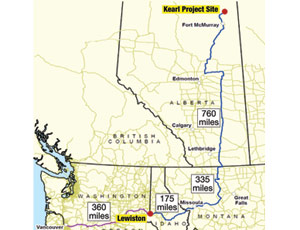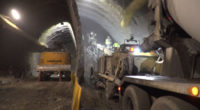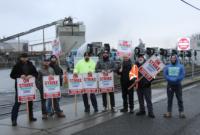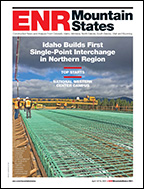Getting supersized prefabricated steel modules to the Kearl oil-sands project in Alberta is proving to be the toughest part of the job for Canada’s Imperial Oil and ExxonMobil Canada. The evidence is in Lewiston, Idaho.


As part of the companies’ $8-billion construction project to produce as much as 345,000 barrels per day of oil roughly 45 miles north of Fort McMurray, Alberta, Imperial Oil sourced 207 prefabricated specialized bitumen plant modules from SungJin Geotec in South Korea.
To avoid transport through the Panama Canal, the Great Lakes and Minnesota, Imperial opted to send them to the Port of Vancouver, Wash. From there, Imperial and the Calgary, Alberta, office of lead contractor Fluor Corp., Irving, Texas, sent the first 44 pieces upriver to Lewiston, where plans called for trucking the pieces on a mountainous—and scenic—highway route through Idaho and Montana before reaching Alberta.
But the needed transportation permits for both Idaho and Montana are on hold, with no decision date in sight.
Imperial Oil expected to start moving the pieces one by one, a process that could take till the end of 2010, says Pius Rolheiser, spokesman at the Calgary-based company. “We have been working with the departments of transportation in Idaho and Montana since the early part of 2008,” he says. “These particular modules represent about 20% of our overall offsite prefabrication.”
The proposal has drawn spirited opposition from environmental groups—including both All Against the Haul and Fighting Goliath—opposed to oil-sands development and concerned that the Northwest Passage Scenic Byway will become a permanent heavy-hauling industrial route. The groups have brought claims in state court against the movement of the modules.
“Some folks … have expressed concerns about U.S. 12 being used for oil equipment shipments and injunctions have been filed,” says Adam Rush, Idaho Dept. of Transportation spokesman.
Oil production rests on receiving these modules, but work is already under way on infrastructure needs, including power lines, roads and the foundation for the open-pit mine that will supply extraction and processing plants. Initial production is pegged at 110,000 barrels per day.
The module’s sizes are unprecedented for Idaho’s and Montana’s transportation departments; Alberta has in place streamlined permitting processes. The largest loads, including truck and trailer, would be 24 ft wide, 30 ft high and 200 ft long. The route covers 175 miles through Idaho, 335 miles through Montana and 760 miles through Alberta.
Imperial Oil has offered to bury overhead power lines and improve and build roadside turnouts all along the route. The improvements to U.S. Highway 12 in Idaho would be $13 million; Montana route modifications would cost $66 million. Imperial Oil proposes transporting three to four modules per week between 11 p.m. and 5 a.m.
But nothing will move without the needed permits, which Imperial Oil still hopes to secure. “We currently have 44 modules [in] Lewiston,” Rolheiser says. “We continue to work through the process. If we arrive at the point where we do not have permits, we would need to look at our options.”
Imperial expected to produce oil from Kearl by the end of 2012 and had built a year into the schedule for moving modules. Receiving permits soon would keep Imperial on schedule, Rolheiser says.






Post a comment to this article
Report Abusive Comment